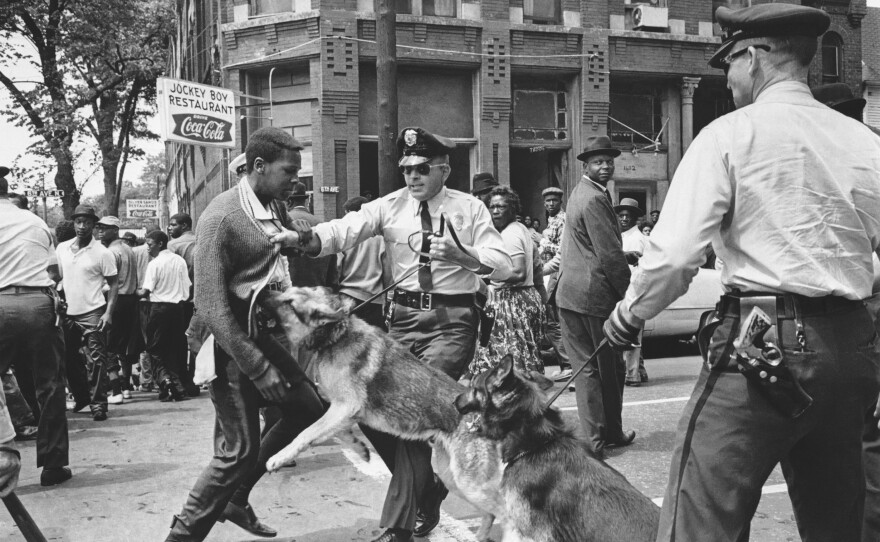Officers surrounded a Valencia Park home close to midnight on Oct. 24, responding to a 911 call that 31-year-old Marcus Evans threatened a woman with a gun.
Body camera footage of the incident has yet to be released. Community members have seen what happened because a freelance videographer showed up and started filming.
“If you’re armed you will be shot or bit,” officers warned Evans inside.
He walked out slowly, hands in the air, in drawstring basketball shorts, no shirt and no shoes, illuminated by police lights.
They told him to stop. He took a few more steps before stopping.
“I’m trying to figure out why you guys are in front of my house,” he said.
“I have no nothing,” he said twice, turning around to show them.
“I’ll sit right here,” he said, easing onto a low wall with his hands still in the air.
Click-click.
“You’re going to be shot!” an officer yelled.
“Why are you going to shoot me?” Evans asked.
Before he received an answer, an officer fired a bean bag at his stomach at about 300 feet per second.
Evans collapsed into the fetal position on the stairs.
“Hands! Hands!” they yelled, and he lifted his hands.
“Why did you shoot me?” he asked.
“If you try and run you will be bit by a police dog,” they said.
He did not try to run.
“I am not — I did nothing wrong,” he said.
He sat back up with his hands up, shaking his head.
“I am concerned because I have not seen your waistband, ” an officer said.
“I am not concerned,” Marcus said.
They shot another bean bag round, injuring his shin, and released a K-9.
He cried out in pain.
“Hey stop! Stop!” he said. “Stop, please!”
The K-9 didn’t bite.
“Why are you trying to shoot me?” he asked again.
They shot another bean bag that hit near his groin, and released another K-9.
He cried out in pain again.
“Please stop!” he said.
The K-9 latched onto Evans’ arm, wrenching it back and forth.
Evans fell onto his back.
Officers surrounded him.
“Please stop! Please!” he said. “I can’t feel my arm.”
The handler choked the dog to get it to release.
They never found a gun, or booked Evans into jail.
According to his lawyer, Dante Pride, Evans had just joined a construction union.
“He was on the path to doing great things, and now he’s been sidelined,” Pride said.
Weeks after the arrest, Evans still couldn’t work, or walk.
He had to change the dressing on his shin twice a day.
He had trouble opening and closing his left hand, and gripping.
A bruised rib made it hard to take deep breaths.
He plans to sue, and ask the court to order San Diego police not to release K-9s on someone on the ground.
“What we saw on that video, what we saw would never, ever happen in Del Mar, never, ever happen in La Jolla, Encinitas, Solana Beach,” Pride said at a news conference announcing the lawsuit. “But when it happens here, it doesn't even make a ripple. Nobody cares. And that's why we're here today, to show and to say, we do care.”
The map below shows the number of K-9 bites by police beat in San Diego between 2019 and November 2024.
Community advocate Tasha Williamson filed excessive force complaints about Evans’ arrest with the police, the FBI and the U.S. Department of Justice Civil Rights Division.
“We are asking Chief Wahl to protect us,” she said. “We are asking people to stand up for us. It doesn't matter what our backgrounds are. It doesn't matter where we come from. It doesn't matter our criminal history. At the time that they make contact with us is how they should move.”
She wants more oversight of the K-9 unit, maybe even community involvement in who it hires.
She said she met with the FBI, and they assigned two agents to the case.
San Diego Police Chief Scott Wahl said they’re reviewing the incident and he is committed to exploring what they could’ve done differently.
Their K-9 unit is big — a few dozen dogs, triple that of Dallas, a similar-sized city.
The San Diego Police Foundation buys the dogs with donations from the community.
The unit was formed in 1984 after a string of suspect and officer deaths. K-9s are less lethal than guns.
They’re meant to find missing people, evidence, drugs and bombs, and de-escalate dangerous situations.
This year, they’ve bitten more than 30 people.
SDPD data show Black people are nine times likelier to be bit by K-9s than white people.
Wahl said the K-9s bite less 2% of times they’re brought out.
As to the racial disparities, Wahl said: “Our bites are not based off of somebody's color of their skin. Our bites are based off of a person's actions.”
Recently, state law required the department to release 2021 body camera footage in which a sergeant said a K-9 “only likes dark meat.”
He’s still on the force.
So is Alan Dyemartin. Sources said it was his K-9 that bit Evans. He did not respond to messages to confirm by publication. A San Diego police spokesperson could not confirm.
In 2018, Dyemartin was disciplined for excessive force on someone who spoke Spanish after he told them to “speak English.”
He was transferred to another division.
Eventually, he was promoted, hired to the K-9 unit, and sent back to the majority Black and Latino neighborhood of Valencia Park.
“Except this time with a dog,” said San Diego Police Officer John Cochran.
Cochran has been with the department for three decades.
He filed an internal complaint about Evans’ arrest.
“Just because you have a call involving a gun, don't mean you get to use any force that you want to do,” he said.
He points to the use of force matrix — a chart showing department policy on how SDPD officers are expected to respond to different situations, including passive resistance: “Behavior that consists of a refusal to comply with verbal commands and does not convey a threat of physical resistance to the officer or another person.”
Cochran believes passive resistance is what Evans displayed.
For passive resistance, officers are allowed to use things like batons and pressure points.
They are not allowed to use extended range weapons like beanbags or K-9s.
Cochran believes it was a violation of policy.
“I just think it's a point where you're torturing people,” he said. “This could have been one less situation where a Black person in San Diego was bitten if they just followed the policies and procedures and common decency,” Cochran said.
He said K-9s have been used on people suspected of non-violent offenses like property crimes.
Christy Lopez, a professor of criminal justice at Georgetown Law, said that’s a national pattern.
“Really, is that that's how you're going to be treated because you stole some lipstick?” she said.
She was a Deputy Chief in the Special Litigation Section of the Civil Rights Division of the DOJ from 2010 to 2017.
She investigated K-9 units across the country, and found they consistently, disproportionately, bit Black people.
She said they’re not like the dog bites people might imagine.
“These are dogs that are bred because of how strong and destructive their bite is. It has been compared to a shark bite, even worse than a shark bite. People have had their scalps ripped off, they have been killed. They have had permanently disfiguring damage, loss of limbs,” she said. “It's really, other than shooting someone, the most injurious use of force that we allow officers to use.”
The American Civil Liberties Union of California found K-9s have severely and permanently injured or killed hundreds of people in the state. Nearly half showed signs of mental health disability.
Lopez said it’s dehumanizing.
“When you use an animal to attack a person, you are to some extent, you know, treating that person like prey, like another animal. And I think it's really hard to overestimate the harm that that causes,” she said.
SDPD K-9s have bit an unarmed naked man.
Stayed latched onto someone who was wearing handcuffs.
Allegedly, jumped a fence and attacked a mother with her 5-year-old.
Lopez said K-9s are still animals, even when they’re well-trained.
“You're never going to be able to ensure that that dog isn't going to attack the wrong person or not let go when they're supposed to and the person has already surrendered. And we would never let an officer use a gun, for example, that would just randomly shoot every once in a while,” she said.
She thinks it’s important to stop using K-9s for apprehension, partly because of the history.

Dogs were used to hunt down enslaved Black people who ran away, and against peaceful Civil Rights protestors.
“Law enforcement using a dog to attack you is something that still has deep resonance in many communities,” she said. “Moving away from that would be an important, meaningful step towards saying, ‘We're not going to police that way anymore.’”
Recent California bills tried to limit the use of K-9s.
Police campaigned against them, including former SDPD Chief David Nisleit.
None of the bills succeeded.
Lopez said in places that have stopped using K-9s, crime hasn’t gone up.
In 2020, Salt Lake City suspended the use of K-9s for apprehension.
Researchers found it had no negative effect on officer or suspect safety.
On Wednesday, the Commission on Police Practices met to review SDPD’s K-9 policy.
K-9 staff described how their unit can de-escalate situations, and how many times the mere presence of the dogs resulted in someone’s surrender without using force.
CPP member Imani Robinson told Chief Wahl: “We’re not feeling protected. We’re feeling hunted.”
Wahl said the review of Evans’ arrest will likely take months.







